
This is the third in a series of vegetative crop features. Previous
issues looked at brachyscome (March 2011) and scaevola (April 2011).
This is the third in a series of vegetative crop features. Previous issues looked at brachyscome (March 2011) and scaevola (April 2011).
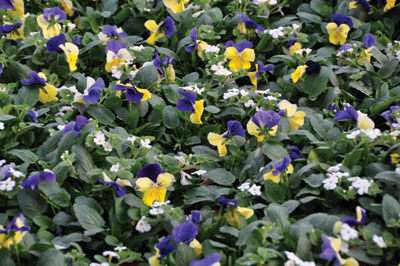 |
| Bacopa stands out with cool pansies. (Photos courtesy Melhem Sawaya) Advertisement
|
Bacopa is a free-flowering plant with a mass of long-lasting, mainly white and blue flowers that do very well in full sun and shade. Bacopa can be used in baskets, mixed planters and 4” pots. The 4” pots can be planted in gardens and used as bedding plants, especially in rock gardens.
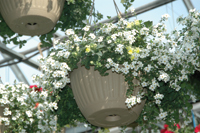
|
|
| Bacopa feels at home with cool crops. | |
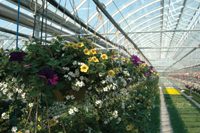
|
|
| Bacopa is excellent in mixes. | |
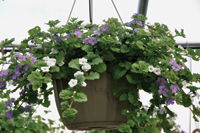 |
|
| Bacopa in a different colour mix. | |
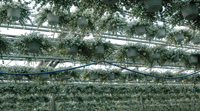
|
|
| Excellent crop of bacopa. | |
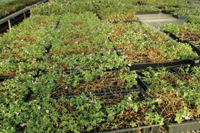 |
|
| Old crowded bacopa liners overtaken by Botrytis.
|
FLOWER INDUCTION
Bacopa is a day-neutral plant and it will flower early in the season under low or high temperatures. The ratio of flowering to vegetative growth is greater under high light levels.
CULTURAL REQUIREMENTS
- Light: Bacopa can survive under a wide range of light levels, but the optimum level is between 2,000 and 8,000 foot-candles.
- Temperature: The temperature range in which bacopa can survive is 0 to 35ºC, with the optimum temperature being 16 to 20ºC. When light levels are low, bacopa should be grown at cooler temperatures. If scheduling is allowed, growing bacopa at 12 to 14ºC will result in an excellent quality plant where the foliage size is doubled, and if cool temperatures are accompanied by high light levels, then the flowers also will be double in size.
- Nutrition: Constant feed is a must, with a fertilizer formulation of the following ratios: nitrogen 3, phosphorus 1, potassium 3, calcium 2, and magnesium 1. The optimum target is for a medium salt level of 1.0 mmhos (with one part soil, two parts water testing). The addition of 1 g/100 L of iron chelate of water every three to four weeks is very beneficial, as is feeding 18-9-18 fertilizer, which is higher in iron and lowers pH. A pH of 5.8–6.0 is optimum.
- Water: Bacopa needs to be evenly moist, but not too wet. Therefore, watering lightly is recommended, especially in the winter months. In order to avoid leaf yellowing, do not let bacopa wilt.
- In the hot summer months, bacopa will flower more but the flower span is very short if the plant is not kept moist. Drying bacopa to the wilting stage will lead to a loss of all flowers and a period of time without any flowers. The recovery of flowering depends on the cultivar. Cultivars with smaller flowers will recover faster than cultivars with large flowers.
PRODUCTION
- Medium: A well-drained soil mix is recommended. A mix of 75 per cent peat and 25 per cent perlite, with a pH adjusted to 5.8, is optimum.
- Planting: Well-established liners are planted into 10” and 4” pots. The soil should be moistened, but not soaked, before planting.
If there are any signs of botrytis or any other disease on the liners, then either the plants should be discarded if they are severely damaged, or a fungicide treatment must be done before planting. This will be more economical and will prevent the disease from spreading, which will be harder to control later on. The main cause of diseases with bacopa are all the conditions that encourage botrytis fungal disease, such as high humidity, watering late at night, tight or no spacing, and old flowers falling on the plants under wet conditions. This is a great recipe for botrytis.
The following is a guide for the number of liners required per pot size and the approximate crop time from liner to finish.
NUMBER OF
LINERS
POT SIZE
CROP TIME
1 4” 5 weeks 1 6” 7 weeks 4 10” 10 weeks 5 12” 10 weeks The crop time for bacopa is subjective in the sense that it will flower early and it will keep growing, thus crop time is in direct relation to the desired finished size.
- Pinching: One pinch for bacopa is recommended. More than that could improve the plant, but it’s usually not necessary since it is a self-branching plant. An application of a registered plant growth regulator is recommended, not for the purpose of branching, but to delay flowering. Experimentation should be practised to get the right timing for your conditions.
- Spacing: Plants can be grown pot-to-pot until they branch and start to touch each other, after which spacing should be implemented. Suggested spacing could be:
- Growth regulators: A B-Nine spray of 2,500 ppm will give bacopa a headache that will last a minimum of three weeks, during which time the plant will not grow. In the early stages of production, use a spray of 850 ppm if a bushier plant with a slight delay in flowering is favourable.
Good growth regulator results are achieved on bacopa with the application of 2 ppm Bonzi. Trials with ethrel applications were also favourable with respect to flower delay and branching. Only low rates are recommended, or leaves could drop.
We should not forget that water frequency, temperature, fertilizer concentration and type, light levels, timing, and a combination of these factors, are more important and more effective than using chemical growth regulators.
| POT SIZE | CENTRE SPACING |
| 4” | 5” |
| 6” | 8” |
| 10” HB | 15” |
| 12” HB | 20” |
At first glance, one would think that the 10” HB needs lots of room, but as noted, spacing is only required when plants are touching. This means that for approximately six weeks of the 10-week period, the hangers are pot-to-pot. Most of the time they are hung up at that point, so bench spacing is cost-effective.
PROBLEMS
- Disease: There isn’t a particular disease that is associated primarily with bacopa. Botrytis can be a big problem if nottreated early in the production cycle; but at the same time, any disease could affect it. I suggest you watch for abnormalities, identify the disease, and apply the appropriate chemical proven effective against that disease. Do not apply the chemical that is handy and available unless it is the right one.
- Insects: Thrips, spider mites and aphids could be found on this plant, so a close watch is recommended in order to apply the appropriate chemical at the early stages. Whiteflies are also known to love the thick under-canopy of bacopa, especially if the crop isvery mature.
- Physiological: Since the plant has very small leaves, very wet conditions are to be avoided, especially in winter months when repeated heavy watering on cloudy days will result in yellow plants. Most recommendations suggest that you add iron to your fertilizer schedule. Normally, however, if you have the right pH and the plants are not overwatered, then iron deficiency is minimized if not eliminated completely.
Also, watch your heat since cold temperatures will cause the media to stay wet for too long, which will hinder iron uptake. Fertilizer rates should be increased during the cold weather since plants do not dry as fast, meaning fertilization frequency is reduced.
SCHEDULE
For bacopa, early flowering is not a problem because it flowers at the early stages of growth and keeps on growing. The schedule is for the optimum plant size at the required time. We gave some recommended guide dates, but the right one is yours to establish under your conditions. Keep the following records so you repeat or adjust the next season:
- Planting date.
- Size of liner and condition.
- Number of liners/containers.
- Cultivar information, since different cultivars of the same genus respond differently.
- Temperatures.
- Light conditions (in general), or how many layers of baskets are above the main crop, if any.
- Fertilization.
- Any specific problems or setbacks.
- Ready time, even if it is not your scheduled selling date.
- Be objective and listen to your employees’ suggestions.
- Write next year’s program and changes by the end of this year, since memory can and will fail!
Melhem Sawaya of Focus Greenhouse Management is a consultant and research coordinator to the horticultural industry. Comments on this or any other article are always welcome; please e-mail mel@focusgreenhousemanagement.com, or visit www.focusgreenhousemanagement.com or www.sawayagardentrials.ca.
Print this page